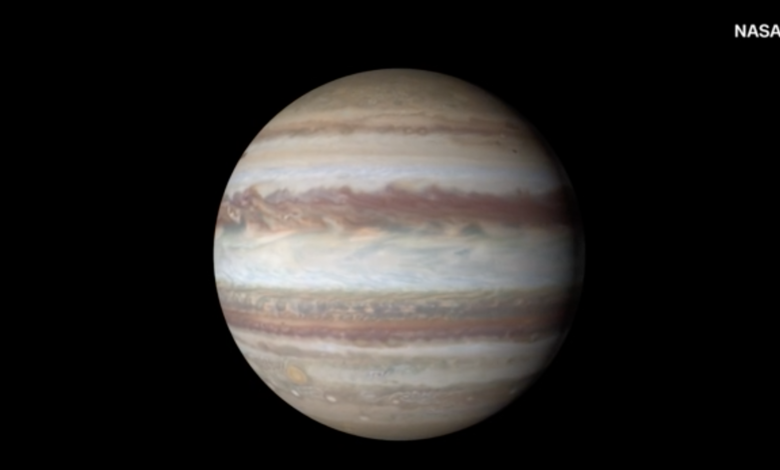

>> IT WAS AN EARLY MORNING DISCOVERY IN THE SKY OVER MILWAUKEE. >> WHAT’S THIS, MATT? >> I’M NERDING OUT A LITTLE BIT, GERRON, THIS IS JUPITER AND YOU CAN SEE THREE OF ITS MANY MOONS. >> MATT SALEMME IN NEWSCHOPPER 12 SHARING THIS EXCLUSIVE VIDEO WITH OUR MORNING NEWS VIEWERS. >> NEXT WEEK IT WILL BE THE CLOSEST THAT IT IS. >> JUPITER IS THE LARGEST PLANET IN THE SOLAR SYSTEM. >> YOU CAN FIT 1,316 EARTHS INSIDE OF JUPITER. >> THE PLANET’S SIZE ALONE HELPS IT SHINE BRIGHT, BUT ITS PLACEMENT DURING ORBIT MATTERS. IT HAPPENS WHEN THE EARTH IS BETWEEN THE SUN AND JUPITER. >> JUPITER IS IT OPPOSITION ON DECEMBER 2016, MEANING OPPOSITE THE SUN. >> BOB BONADURER RUNS THE PLANETARIUM AT THE MILWAUKEE PUBLIC MUSEUM. HE SAYS THE OPPOSITION HAPPENS EVERY 13 MONTHS. >> IS CLOSER TO THE EARTH AND ITS ORBIT, 20% CLOSER AND IT SHINES BRIGHTER THAN ANY STAR IN THE NIGHT SKY. >> NASA REPORTS THIS AS THE CLOSEST JUPITER WILL BE IN ORBIT TO EARTH IN ALMOST 60 YEARS. WHEN YOU STAR GAZE OVER THE NEXT WEEK ALL YOU REALLY NEED ARE YOUR EYES. YOU’LL EVEN BE ABLE TO SPOT OTHER PLANETS TOO. >> IN THE SOUTHEAST YOU WILL SEE THE PLANET SATURN, NOT QUITE AS BRIGHT. FOR PEOPLE UP LATER YOU WILL SEE THE PLANET MARS RISING. TOYA: THE MILWAUKEE PUBLIC MUSE
Jupiter will make its closest approach to Earth in 59 years on Monday, Sept. 26, according to NASA.The largest planet in our solar system, the gas giant will be at opposition, meaning Earth is directly between it and the sun, said Trina L. Ray, deputy science manager for the Europa Clipper mission at NASA's Jet Propulsion Laboratory in Pasadena, California.The space agency originally said Jupiter would be making its closest approach to Earth in 70 years, but corrected its statement after discovering the error, a NASA spokesperson said.There will be about 367 million miles (590.6 million kilometers) between Earth and Jupiter, according to NASA. Jupiter is about 600 million miles (965.6 million kilometers) away from our home planet at its farthest point, the space agency said.Jupiter is at opposition about every 13 months, the length of time the Earth takes to orbit the Sun in relation to Jupiter, according to EarthSky.Neither Earth nor Jupiter orbits the sun in a perfect circle, which is what makes each opposition a slightly different distance, said Ray, who is also NASA's investigation scientist for the Radar for Europa Assessment and Sounding: Ocean to Near-surface, or REASON.How to watchJupiter will appear brighter and bigger in the sky, making the event a great opportunity to catch a glimpse, NASA said.The gaseous planet will rise around sunset and look pearly white to the naked eye, said Patrick Hartigan, professor of physics and astronomy at Rice University in Houston.With a pair of binoculars or a telescope, you will be able to see the planet's bands, according to NASA.Stargazers may also be able to see three or four of Jupiter's moons, including Europa, Ray said."Since I am working on a spacecraft that we are going to send to the Jupiter system to explore Europa," she said, "I'm always excited to see Jupiter and even Europa with my own eyes." Saturn and Mars will also be visible, so try and spot those planets while viewing Jupiter's opposition, Hartigan said.Other events in 2022 Catch the peak of these upcoming meteor shower events later this year, according to EarthSky's 2022 meteor shower guide:Draconids: Oct. 8-9 Orionids: Oct. 20-21 South Taurids: Nov. 5 North Taurids: Nov. 12 Leonids: Nov. 17-18 Geminids: Dec. 13-14 Ursids: Dec. 22-23
Jupiter will make its closest approach to Earth in 59 years on Monday, Sept. 26, according to NASA.
The largest planet in our solar system, the gas giant will be at opposition, meaning Earth is directly between it and the sun, said Trina L. Ray, deputy science manager for the Europa Clipper mission at NASA's Jet Propulsion Laboratory in Pasadena, California.
The space agency originally said Jupiter would be making its closest approach to Earth in 70 years, but corrected its statement after discovering the error, a NASA spokesperson said.
There will be about 367 million miles (590.6 million kilometers) between Earth and Jupiter, according to NASA. Jupiter is about 600 million miles (965.6 million kilometers) away from our home planet at its farthest point, the space agency said.
Jupiter is at opposition about every 13 months, the length of time the Earth takes to orbit the Sun in relation to Jupiter, according to EarthSky.
Neither Earth nor Jupiter orbits the sun in a perfect circle, which is what makes each opposition a slightly different distance, said Ray, who is also NASA's investigation scientist for the Radar for Europa Assessment and Sounding: Ocean to Near-surface, or REASON.
How to watch
Jupiter will appear brighter and bigger in the sky, making the event a great opportunity to catch a glimpse, NASA said.
The gaseous planet will rise around sunset and look pearly white to the naked eye, said Patrick Hartigan, professor of physics and astronomy at Rice University in Houston.
With a pair of binoculars or a telescope, you will be able to see the planet's bands, according to NASA.
Stargazers may also be able to see three or four of Jupiter's moons, including Europa, Ray said.
"Since I am working on a spacecraft that we are going to send to the Jupiter system to explore Europa," she said, "I'm always excited to see Jupiter and even Europa with my own eyes."
Saturn and Mars will also be visible, so try and spot those planets while viewing Jupiter's opposition, Hartigan said.
Other events in 2022
Catch the peak of these upcoming meteor shower events later this year, according to EarthSky's 2022 meteor shower guide:
Source link







